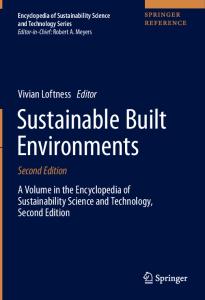Damage and the Built Environment
- PDF / 4,100,019 Bytes
- 65 Pages / 595.276 x 790.866 pts Page_size
- 1 Downloads / 384 Views
DAMAGE AND THE BUILT ENVIRONMENT Adriana Galderisi, Andrea Ceudech University of Naples “Federico II”, Naples, Italy
Synonyms Losses; Urban areas; Urban environment Definition Damage: Losses, injuries, failures, or troubles which may occur in a given area as a consequence of the impact of a hazard on exposed and vulnerable elements and systems. Types and amount of damage depend on the features of both hazards and exposed elements and systems. Built environment: The areas most modified by human beings, where people and all man-made structures are concentrated. It is generally opposite to the natural environment, even though close relationships between the built and natural environments are largely recognized. Built environments can greatly differ, in terms of spatial and functional patterns. The various types of built environments respond differently to hazards: that is, a densely built up historical city and a recent low-density urban area have a different susceptibility to damage from a given hazard. Introduction The damage due to natural hazards in built environments generally refers to the physical destruction to man-made structures and to the impacts on people. These types of damages are generally defined as direct damages and occur at the onset of a disaster or shortly thereafter. Direct damages can be due both to a primary hazard or to its impact on exposed vulnerable elements which represent, in turn, further hazard sources: for example, damages to buildings or people due to fires following an earthquake
which causes, in turn, breaks in gas pipelines. Such damages are very common in the built environment, as clearly highlighted by several disasters that have occurred in the recent past. Nevertheless, in many cases, official reports do not distinguish the damages in relation to the different hazard sources. Besides direct damages, indirect ones may occur and can result from physical damages affecting the functioning of some elements or systems (hospitals, lifelines, etc.) or inducing economic consequences (temporary unemployment due to physical damages to industries). Indirect damages may even occur over a long period of time after the event, affecting broader areas than that directly hit by the hazard. Permanent or temporary losses in relevant economic activities at local scale can reverberate on macroeconomic variables. By their nature, indirect damages are harder to quantify than physical ones. The amount of indirect damages may constitute the majority of the total losses in large disasters affecting urban areas. Nevertheless, long-term indirect damages are frequently neglected, mainly in official reports often designed to provide governments with estimates of the amount of funds required to address emergency and reconstruction needs. The overall damage is quantified in terms of economic losses, generally including direct damages and the most relevant economic effects, as well as distinguishing the insured losses within the overall amount. It is worth noting that in many cases, the evaluation of indirect
Data Loading...











